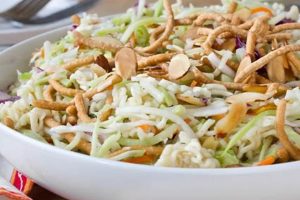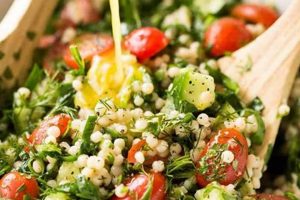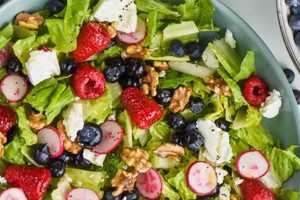A culinary creation featuring a combination of various seafood, such as shrimp, scallops, calamari, mussels, crab, or fish, typically chilled and tossed with a flavorful dressing. These dishes often incorporate fresh vegetables, herbs, and occasionally pasta or grains, resulting in a light yet satisfying meal. Variations exist across cultures, reflecting regional tastes and available ingredients. For example, a Mediterranean version might include octopus, olives, and feta cheese, while an Asian-inspired rendition might feature seaweed, sesame oil, and ginger.
Such dishes offer a range of nutritional benefits, providing a good source of protein, omega-3 fatty acids, and essential vitamins and minerals. Historically, combining readily available seafood with seasonal produce represents a practical and efficient way to create a complete and balanced meal. This tradition continues to resonate in modern cuisine, appreciated for its fresh flavors and adaptability to diverse dietary preferences. From simple picnic fare to elegant appetizers, the combination of seafood and complementary ingredients remains a popular culinary choice.
This exploration will delve into different types of preparations, offering guidance on ingredient selection, preparation techniques, and dressing options to create a delightful and nutritious culinary experience. Specific recipes will be provided, catering to a range of tastes and skill levels, from novice cooks to experienced chefs.
Tips for Creating Exceptional Seafood Salad
Achieving optimal flavor and texture requires careful consideration of ingredient selection, preparation methods, and complementary components. The following tips offer guidance for crafting a truly remarkable culinary experience.
Tip 1: Seafood Selection: Opt for high-quality, fresh seafood. Consider a variety of textures and flavors for a more complex and interesting dish. Properly stored and handled seafood is crucial for food safety.
Tip 2: Balancing Flavors: Achieve a harmonious blend by combining delicate and robust seafood flavors. Lighter fish, such as cod or flounder, pair well with bolder options like shrimp or mussels.
Tip 3: Texture Considerations: Vary textures for an engaging culinary experience. Combine tender flakes of fish with firmer shrimp or calamari. The addition of crisp vegetables further enhances textural contrast.
Tip 4: Dressing Choices: Select a dressing that complements the seafood and other ingredients. A light vinaigrette, a creamy dressing, or a citrus-based sauce can enhance the overall flavor profile.
Tip 5: Fresh Herbs and Seasoning: Elevate the flavor profile by incorporating fresh herbs such as dill, parsley, or chives. Careful seasoning with salt, pepper, and other spices enhances the natural flavors of the seafood.
Tip 6: Chill Time: Allowing the salad to chill for a period allows the flavors to meld and develop. This enhances the overall taste experience.
Tip 7: Presentation Matters: Thoughtful plating enhances the visual appeal. Consider serving the salad on a bed of greens, or garnishing with fresh herbs and edible flowers.
By adhering to these guidelines, one can ensure a well-balanced, flavorful, and visually appealing seafood salad. Attention to detail, from ingredient selection to presentation, contributes significantly to a truly satisfying culinary experience.
These principles provide a foundation for exploring specific recipe variations and adapting them to individual preferences and dietary needs, culminating in a truly personalized and enjoyable dining experience.
1. Fresh, High-Quality Seafood
The foundation of any successful mixed seafood salad rests upon the selection of fresh, high-quality seafood. This foundational element dictates not only the flavor profile but also the overall safety and enjoyment of the dish. Substandard ingredients can compromise the delicate balance of flavors and textures, resulting in a less satisfying culinary experience.
- Sourcing and Selection
Sourcing seafood from reputable suppliers who prioritize sustainable practices is essential. Look for clear eyes, firm flesh, and a fresh, sea-like aroma. Avoid seafood with a strong fishy odor or slimy texture. Selecting a variety of seafood, such as firm shrimp alongside flaky cod, contributes to a more complex and engaging salad.
- Proper Handling and Storage
Maintaining the cold chain is crucial for preserving freshness and preventing bacterial growth. Seafood should be kept chilled at or below 40F (4C) from the moment of purchase until it is ready to be prepared. Proper storage techniques, such as wrapping seafood tightly in plastic wrap or storing it in airtight containers, help maintain its quality.
- Flavor and Texture Considerations
Fresh, high-quality seafood possesses a delicate, naturally sweet flavor. This allows the inherent flavors of the seafood to shine through, complementing the other ingredients in the salad. The texture should be firm and resilient, offering a pleasant mouthfeel. Overly soft or mushy seafood indicates a decline in quality.
- Impact on the Final Dish
The quality of the seafood directly impacts the overall taste, texture, and visual appeal of the mixed seafood salad. Fresh seafood contributes a clean, bright flavor, while properly handled seafood maintains a desirable texture. These factors contribute significantly to the overall enjoyment and satisfaction derived from the dish.
By prioritizing fresh, high-quality seafood, one ensures not only a delicious but also a safe and enjoyable culinary experience. The careful selection and handling of ingredients elevate the mixed seafood salad from a simple dish to a truly exceptional culinary creation.
2. Complementary Flavor Profiles
Flavor balance is crucial in a mixed seafood salad. The inherent flavors of different seafood types must harmonize with other ingredients. Pairing robust, oily fish like salmon or tuna with milder options such as cod or scallops creates a complex flavor profile. This interplay prevents any single flavor from dominating, resulting in a well-rounded and enjoyable experience. The concept extends beyond seafood selection. Acidic elements, such as lemon juice or vinegar, cut through richness, while herbs and spices add depth and complexity. A salad featuring grilled salmon, delicate bay scallops, a lemon-herb vinaigrette, and fresh dill exemplifies complementary flavors.
Achieving flavor balance requires careful consideration of ingredient pairings. A successful mixed seafood salad strategically combines ingredients with contrasting yet complementary flavors. For example, the sweetness of crab meat pairs well with the briny, salty notes of olives and capers. The addition of a citrus vinaigrette further enhances these flavors, adding a refreshing acidity that cuts through the richness of the seafood. Similarly, the earthiness of mussels complements the brightness of a tomato-based dressing. Understanding these flavor relationships allows for the creation of a well-balanced and harmonious salad.
Mastering the art of complementary flavor profiles elevates a mixed seafood salad from a simple combination of ingredients to a sophisticated culinary creation. Careful attention to flavor pairings ensures a balanced and harmonious taste experience. This principle, applied thoughtfully, transforms individual components into a cohesive and delightful whole, enriching the sensory experience of the dish.
3. Varied Textural Elements
Textural diversity is essential for a compelling mixed seafood salad. A combination of textures elevates the dish beyond simple sustenance, creating a multi-sensory dining experience. The interplay of contrasting textures adds depth and complexity, engaging the palate and enhancing enjoyment.
- Seafood Selection:
Different seafood types offer distinct textures. Flaky fish like cod contrasts with the firm snap of shrimp or the chewiness of calamari. Incorporating a variety of seafood creates textural intrigue, preventing monotony and enhancing the overall experience.
- Vegetable Incorporation:
Crisp vegetables, such as celery, bell peppers, or cucumbers, provide a refreshing counterpoint to the softer textures of seafood. Blanched or roasted vegetables offer a slightly different textural dimension, while leafy greens contribute a delicate touch. The strategic inclusion of vegetables enhances both the textural and flavor complexity of the salad.
- Additional Elements:
Nuts, seeds, or croutons introduce crunchy elements, further diversifying the textural profile. These additions provide contrasting sensations, enhancing the overall sensory experience. Consider toasting nuts or seeds to amplify their crunch and impart a deeper flavor.
- Balancing Textures:
The key lies in achieving a harmonious balance of textures. Too much of any single texture can lead to an unbalanced and less satisfying dish. A well-composed salad incorporates a range of textures in appropriate proportions, ensuring a dynamic and engaging experience with each bite. For instance, a salad might combine flaky poached cod, tender shrimp, crisp cucumber, and crunchy toasted almonds.
The considered incorporation of varied textural elements transforms a mixed seafood salad into a more sophisticated and satisfying dish. This attention to detail elevates the culinary experience, engaging multiple senses and enhancing overall enjoyment. The interplay of textures adds depth and complexity, making each bite a delightful exploration of contrasting sensations.
4. Appropriate Dressing Selection
The dressing serves as a unifying element in a mixed seafood salad, binding the diverse ingredients and influencing the overall flavor profile. A thoughtfully chosen dressing complements the delicate flavors of the seafood and other components, enhancing rather than masking their inherent qualities. An inappropriate dressing, conversely, can overpower the subtle nuances of the seafood, resulting in a less harmonious and enjoyable dish. Therefore, careful consideration of dressing selection is paramount in creating a well-balanced and flavorful mixed seafood salad.
- Flavor Compatibility:
The dressing’s flavor profile should harmonize with the seafood and other ingredients. A light vinaigrette with citrus notes complements delicate white fish and shellfish, while a richer, creamier dressing might pair well with bolder flavors like salmon or tuna. The dressing should enhance, not compete with, the natural flavors of the seafood. For example, a lemon-dill vinaigrette brightens a salad with shrimp and scallops, while a creamy avocado dressing complements a salad with smoked salmon and crab.
- Acidity and Balance:
The acidity level of the dressing plays a critical role in balancing the richness of the seafood. A vinaigrette with a touch of acidity cuts through the fattiness of certain seafood, creating a more refreshing and palatable experience. However, excessive acidity can overpower delicate flavors. A balanced approach is key, ensuring that the acidity enhances rather than dominates the overall flavor profile. A lemon vinaigrette provides balanced acidity for a salad with shrimp, scallops, and avocado, preventing the avocado from becoming overly rich.
- Texture and Consistency:
The dressing’s texture and consistency should complement the other elements in the salad. A light vinaigrette coats the ingredients evenly without weighing them down, while a thicker, creamier dressing clings more readily to the seafood and vegetables. The choice depends on the desired outcome and the overall composition of the salad. A light vinaigrette is suitable for a salad with flaky fish and crisp vegetables, while a creamy dressing works well with heartier seafood and pasta.
- Ingredient Synergy:
The dressing should create synergy among the various ingredients in the salad. It should tie the flavors together, creating a cohesive and harmonious whole. A well-chosen dressing enhances the individual characteristics of each component while simultaneously unifying them into a single, delicious dish. A cilantro-lime dressing blends the flavors of shrimp, avocado, mango, and red onion, creating a cohesive and flavorful salad.
Selecting an appropriate dressing is essential for creating a balanced and flavorful mixed seafood salad. Careful consideration of flavor compatibility, acidity, texture, and ingredient synergy ensures that the dressing enhances the overall composition of the salad, creating a harmonious and enjoyable culinary experience. The right dressing elevates the dish from a simple combination of ingredients to a carefully crafted culinary creation.
5. Proper Chilling and Serving
Proper chilling and serving are critical to both the safety and enjoyment of a mixed seafood salad. Chilling allows flavors to meld and deepen, enhancing the overall taste experience. More importantly, maintaining a safe temperature inhibits bacterial growth, a significant concern with seafood. Insufficient chilling can lead to spoilage and potential foodborne illness. Ideally, the salad should be chilled thoroughly after preparation, maintaining a temperature of 40F (4C) or below. Serving chilled ensures optimal food safety and preserves the intended flavor profile. A seafood salad served warm not only compromises flavor but also increases the risk of bacterial proliferation. For instance, a classic shrimp salad with mayonnaise requires thorough chilling to both enhance flavor and prevent spoilage due to the mayonnaise-based dressing.
Beyond food safety, proper chilling influences texture. Seafood becomes firmer when chilled, improving the overall mouthfeel of the salad. This firmness also prevents the seafood from becoming mushy, a common issue with warm or room-temperature seafood salads. The chilling process also allows the dressing to emulsify fully, coating the ingredients evenly and contributing to a cohesive texture. Consider a ceviche, where the chilling process “cooks” the seafood in citrus juices; serving this dish warm would negate this crucial element of its preparation and alter its intended texture and flavor. Conversely, over-chilling can negatively impact certain ingredients, such as tomatoes, which can lose flavor and texture when exposed to excessively cold temperatures. Therefore, a balanced approach is required, ensuring adequate chilling without compromising the quality of delicate components.
Successful mixed seafood salad preparation hinges on meticulous attention to chilling and serving temperatures. This practice not only safeguards against foodborne illnesses but also optimizes flavor and texture. Understanding the impact of temperature on seafood and other ingredients allows for informed decisions throughout the preparation process. From initial ingredient selection to final presentation, maintaining appropriate temperatures ensures a delicious and safe dining experience. Neglecting this crucial step can compromise both the quality and safety of the dish, underscoring its significance in the overall preparation process.
Frequently Asked Questions
This section addresses common inquiries regarding the preparation and enjoyment of mixed seafood salads, providing clear and concise information to ensure a successful culinary experience.
Question 1: How does one ensure the seafood used is fresh?
Sourcing seafood from reputable fishmongers or markets known for quality control is paramount. Indicators of freshness include a clean, briny scent, firm texture, and clear, bright eyes. Avoid seafood with a strong, fishy odor, dull appearance, or slimy texture.
Question 2: What are the best seafood combinations for a mixed salad?
Combining different textures and flavor profiles creates a more complex and enjoyable salad. Consider pairing flaky fish, such as cod or flounder, with firmer options like shrimp or scallops. The inclusion of shellfish, such as mussels or clams, adds another dimension of flavor and texture.
Question 3: What types of dressings are most suitable?
Light vinaigrettes with citrus or herb notes often complement the delicate flavors of seafood. Creamy dressings, such as those based on mayonnaise or yogurt, offer a richer alternative. The dressing should complement, not overpower, the seafood and other ingredients.
Question 4: How long can mixed seafood salad be stored safely?
Due to the perishable nature of seafood, refrigeration is crucial. Ideally, consume the salad within 24 hours of preparation. Store the salad in an airtight container at or below 40F (4C) to minimize bacterial growth and maintain quality.
Question 5: Can mixed seafood salad be frozen?
Freezing is generally not recommended. Freezing can negatively impact the texture of seafood, resulting in a mushy consistency upon thawing. Additionally, the delicate flavors of the seafood and other ingredients may be compromised by the freezing process.
Question 6: What are some common allergens to consider when preparing or serving this dish?
Shellfish allergies are prevalent. Individuals with shellfish allergies must avoid mixed seafood salads containing shrimp, crab, lobster, or other crustaceans. Cross-contamination during preparation should also be avoided. Clearly label ingredients and inform guests of potential allergens.
Prioritizing fresh ingredients, appropriate storage, and careful handling ensures a safe and enjoyable dining experience. Awareness of potential allergens and their management is crucial for accommodating dietary restrictions.
This concludes the frequently asked questions section. The following sections will provide detailed recipes and variations for creating your own mixed seafood salad.
Conclusion
Careful consideration of ingredient quality, flavor pairings, textural variety, dressing selection, and temperature control are crucial elements for a successful mixed seafood salad. From sourcing fresh seafood to balancing flavors and textures, each step contributes significantly to the final product. Proper chilling and serving practices ensure both food safety and optimal enjoyment. Understanding these key principles allows for informed decisions throughout the preparation process, transforming a simple combination of ingredients into a carefully crafted culinary creation.
The enduring appeal of mixed seafood salads lies in their adaptability and versatility. From simple, everyday meals to elegant appetizers, these culinary creations offer a refreshing and nutritious dining experience. By applying the principles outlined herein, culinary enthusiasts of all skill levels can achieve consistently delicious and satisfying results. Continued exploration of flavor combinations and innovative ingredient pairings promises an ongoing evolution of this classic dish, ensuring its enduring presence in culinary traditions worldwide.






